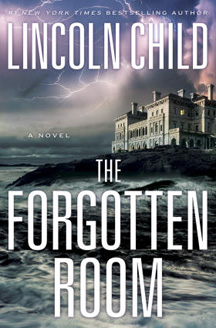It took several Douglas Preston & Lincoln Child novels for Pendergast to become an icon, so it’s no wonder that the other ongoing characters in the authors’ works are taking a while to build into something. The duo is starting to make headway with Gideon Crew through three novels, and now Child is making progress with Professor Jeremy Logan in Logan’s third novel (and Child’s sixth solo book), “The Forgotten Room” (May, hardcover), a rather light and breezy effort compared to most of his books.
Logan is an enigmalogist – a ghost hunter, in layman’s terms – but Child’s solo books tend to veer toward traditional roads of science (or at least sci-fi). Logan’s second appearance, “The Third Gate,” was Child’s best book, but because of the great Nile River-based setting, not because of Logan or his ghost hunting. In “The Forgotten Room,” Logan is called in to Lux — a Newport, R.I., think tank he used to work at — to investigate a suicide where the normally sane fellow Willard Strachey snapped and decapitated himself with a heavy window.
After the expected scenes of the think tank’s scientists scoffing at Logan’s field of expertise, Logan begins investigating, and the answers seem to be more rooted in science than the supernatural. It’s as if Child is intrigued by the idea of a ghost hunter as a main character, but his personal interests send his yarns in the direction of science, albeit of the weird variety.
Child touches upon the idea of synesthesia – where one’s senses get mixed up, so you can taste colors, feel sounds, etc. – and tries to make music spooky. The idea of scary music doesn’t quite work in book form, although it would translate to film, I’m sure.
Lux offers up delicious architectural creepiness in the vein of the New York Museum of Natural History (a favorite locale in the Pendergast books). While the think-tank residents live and work in the East Wing, Strachey had been renovating the West Wing, which had been abandoned for decades due to the residents getting tired of the bizarre lack of hallways, meaning each room had to be accessed by going through other rooms. (I assume the building violated the fire code, too.)
Aside from brief visits to Newport, which Child paints as a beautiful seaside town, all the action takes place at Lux. So this isn’t a geographic smorgasbord like “The Third Gate.” Logan (who debuted in “Deep Storm”) is gradually becoming a likable character, even if he continues to venture outside his field of expertise.
“The Forgotten Room” is a simple, 290-page Child novel that ranks somewhere in the middle of the pack among his work – a notch better than “Death Match” and “Terminal Freeze,” but not as evocative as “Utopia,” “Deep Storm” or “The Third Gate.” Child is on a pattern where his odd-numbered books are great and his even-numbered books are merely good. Still, I gotta give him major credit for that title: You want to know what’s in that room, don’t you?


